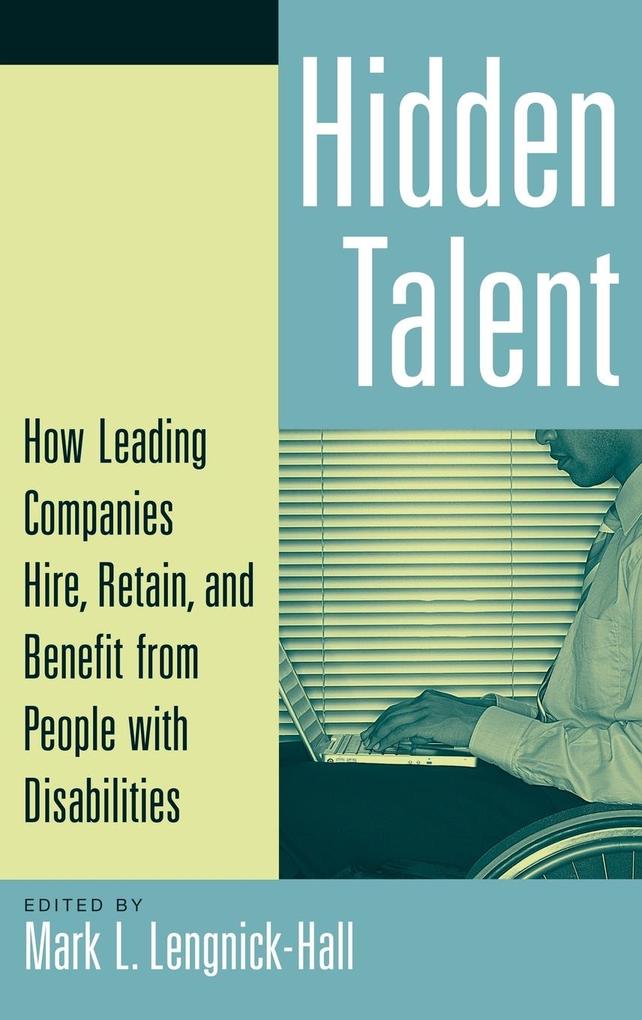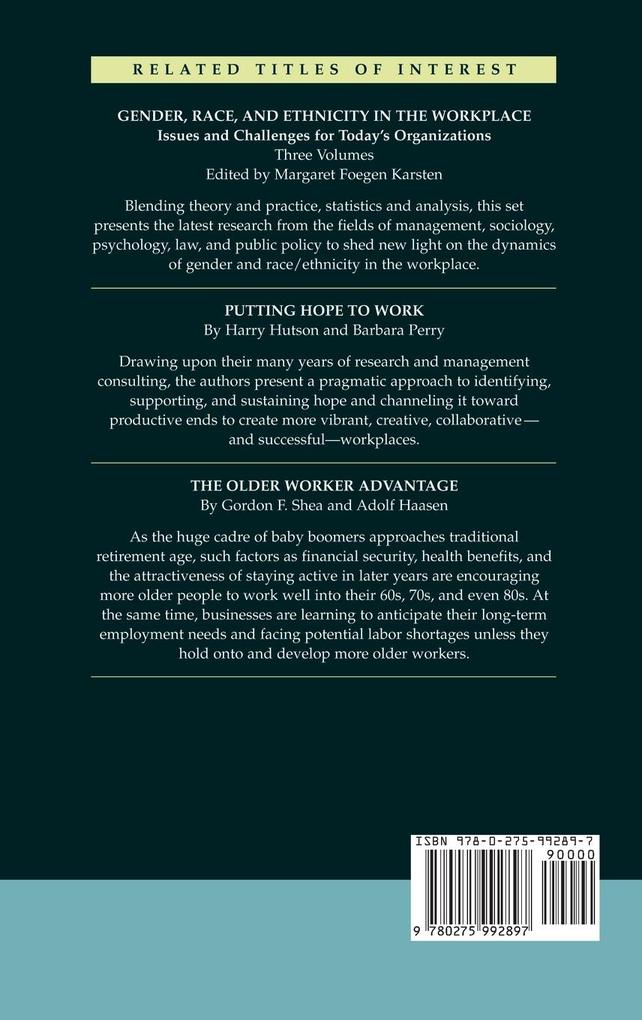
Zustellung: Do, 12.06. - Mo, 16.06.
Versand in 1-2 Wochen
VersandkostenfreiBestellen & in Filiale abholen:
Despite the passage of the Americans with Disabilities Act in 1990, many forms of discrimination against people with disabilities are still practiced, denying opportunity for employees, as well as the employers who might hire and support them. Based on a multi-year research project by a team of experts in human resource management, economics, and communications, Hidden Talent showcases the innovative practices of organizations that are actively hiring, training, and retaining people with disabilities-and thriving as a result. The authors reveal the roots of disability discrimination and demonstrate the benefits, to employers and employees alike, of investing in disabled workers, featuring in-depth case examples. Additional resources, including an overview of the ADA, information on tax and legal incentives, and listing of related publications, organizations, and websites, will make this book essential for anyone researching, managing, or experiencing the dynamics of disability in the workplace.
The Americans with Disabilities Act was signed into law in 1990 to protect and assist over 20 million people with disabilities. Though its mandates for business are far-reaching, many forms of discrimination are still practiced, denying opportunity for employees and potential employees with disabilites, as well as the companies that might hire and support them. Meanwhile, as many analysts argue, we are heading toward a high-skill labor shortage, with a largely untapped resource ready to fill the gap.
Based on a multi-year research project by a team of experts in human resource management, economics, and communications, Hidden Talent showcases the innovative practices of organizations that are actively hiring, training, and retaining people with disabilities-and thriving as a result. The authors reveal the roots of disability discrimination, and demonstrate the benefits, to employers and employees alike, of investing in disabled workers, featuring in-depth case examples. Additional resources, including an overview of the ADA, information on tax and legal incentives, and a listing of related publications, organizations, and websites, will make this book essential for anyone researching, managing, or experiencing the dynamics of disability in the workplace.
The Americans with Disabilities Act was signed into law in 1990 to protect and assist over 20 million people with disabilities. Though its mandates for business are far-reaching, many forms of discrimination are still practiced, denying opportunity for employees and potential employees with disabilites, as well as the companies that might hire and support them. Meanwhile, as many analysts argue, we are heading toward a high-skill labor shortage, with a largely untapped resource ready to fill the gap.
Based on a multi-year research project by a team of experts in human resource management, economics, and communications, Hidden Talent showcases the innovative practices of organizations that are actively hiring, training, and retaining people with disabilities-and thriving as a result. The authors reveal the roots of disability discrimination, and demonstrate the benefits, to employers and employees alike, of investing in disabled workers, featuring in-depth case examples. Additional resources, including an overview of the ADA, information on tax and legal incentives, and a listing of related publications, organizations, and websites, will make this book essential for anyone researching, managing, or experiencing the dynamics of disability in the workplace.
Inhaltsverzeichnis
Preface
Robert R. Hull
Introduction
Mark L. Lengnick-Hall
Section One The Problem and the Opportunity: People with Disabilities Need Jobs and Employers Need Workers
Chapter 1 Where Will Businesses Find the Workers They Need in the Future?
Jodi Messer Pelkowski
Chapter 2 Why Employers Don't Hire People with Disabilities
Mark L. Lengnick-Hall and Philip Gaunt
Section Two Solutions: What Some Leading Companies Are Doing to Hire and Retain People with Disabilities
Chapter 3 Hewlett-Packard
Philip Gaunt
Chapter 4 Dow Chemical Company
Robert R. Hull
Chapter 5 SunTrust Banks
Nancy Bereman and Stephanie J. Hargrave
Chapter 6 A&F Wood Products
Philip Gaunt
Chapter 7 Giant Eagle Inc.
Nancy Bereman and Stephanie J. Hargrave
Chapter 8 Microsoft
Mark L. Lengnick-Hall
Chapter 9 Marriott International
Robert R. Hull
Section Three Lessons Learned about Hiring and Retaining People with Disabilities
Chapter 10 The Business Case for Hiring People with Disabilities
Mark L. Lengnick-Hall
Chapter 11 Creating a Disability-Friendly Organizational Culture and Climate
Mark L. Lengnick-Hall
Chapter 12 Conclusion
Mark L. Lengnick-Hall
Appendixes
Appendix 1 Tax Incentives for Hiring People with Disabilities
Robert R. Hull
Appendix 2 Resources for Hiring People with Disabilities
Robert R. Hull
Appendix 3 The Cerebral Palsy Research Foundation
Robert R. Hull
Appendix 4 The Americans with Disabilities Act (1990)
Mark L. Lengnick-Hall
Notes
Index
About the Editor and Contributors
Robert R. Hull
Introduction
Mark L. Lengnick-Hall
Section One The Problem and the Opportunity: People with Disabilities Need Jobs and Employers Need Workers
Chapter 1 Where Will Businesses Find the Workers They Need in the Future?
Jodi Messer Pelkowski
Chapter 2 Why Employers Don't Hire People with Disabilities
Mark L. Lengnick-Hall and Philip Gaunt
Section Two Solutions: What Some Leading Companies Are Doing to Hire and Retain People with Disabilities
Chapter 3 Hewlett-Packard
Philip Gaunt
Chapter 4 Dow Chemical Company
Robert R. Hull
Chapter 5 SunTrust Banks
Nancy Bereman and Stephanie J. Hargrave
Chapter 6 A&F Wood Products
Philip Gaunt
Chapter 7 Giant Eagle Inc.
Nancy Bereman and Stephanie J. Hargrave
Chapter 8 Microsoft
Mark L. Lengnick-Hall
Chapter 9 Marriott International
Robert R. Hull
Section Three Lessons Learned about Hiring and Retaining People with Disabilities
Chapter 10 The Business Case for Hiring People with Disabilities
Mark L. Lengnick-Hall
Chapter 11 Creating a Disability-Friendly Organizational Culture and Climate
Mark L. Lengnick-Hall
Chapter 12 Conclusion
Mark L. Lengnick-Hall
Appendixes
Appendix 1 Tax Incentives for Hiring People with Disabilities
Robert R. Hull
Appendix 2 Resources for Hiring People with Disabilities
Robert R. Hull
Appendix 3 The Cerebral Palsy Research Foundation
Robert R. Hull
Appendix 4 The Americans with Disabilities Act (1990)
Mark L. Lengnick-Hall
Notes
Index
About the Editor and Contributors
Produktdetails
Erscheinungsdatum
30. April 2007
Sprache
englisch
Seitenanzahl
170
Herausgegeben von
Mark Lengnick-Hall
Verlag/Hersteller
Produktart
gebunden
Gewicht
426 g
Größe (L/B/H)
240/161/14 mm
ISBN
9780275992897
Entdecken Sie mehr
Pressestimmen
"Lengnick-Hall has edited a highly readable and informative book that attempts to persuade readers of the benefits of hiring people with disabilities. Although employers may be hesitant to hire disabled persons for various reasons, Lengnick-Hall and his academic and research colleagues dispel myths surrounding disabled employees, citing examples of companies that were proactive in hiring the disabled and thrived as a result. The seven case studies included in the text, each one its own chapter, read like a conversation, with practical advice and lessons learned provided at the end. Further resources include a section on tax incentives for employers and a basic introduction to the Americans with Disabilities Act (1990). Although brief, the seven case studies, along with the research discussed in the book, successfully highlight the message that hiring people with disabilities puts companies at a competitive advantage. Any individual interested in learning about this topic, and particularly managers in the early stages of changing organizational culture for purposes of being more disability-friendly, would gain from reading this book....Recommended. General readers; all levels of undergraduate students; and practitioners." - Choice
Bewertungen
0 Bewertungen
Es wurden noch keine Bewertungen abgegeben. Schreiben Sie die erste Bewertung zu "Hidden Talent" und helfen Sie damit anderen bei der Kaufentscheidung.










